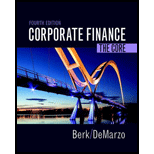
Concept explainers
Your firm is thinking of expanding. If you invest today, the expansion will generate $10 million in FCF at the end of the year, and will have a continuation value of either $150 million (if the economy improves) or $50 million (if the economy does not improve). If you wait until next year to invest, you will lose the opportunity to make $10 million in FCF, but you will know the continuation value of the investment in the following year (that is, in a year from now, you will know what the investment continuation value will be in the following year). Suppose the risk-free rate is 5%, and the risk-neutral probability that the economy improves is 45%. Assume the cost of expanding is the same this year or next year.
- a. If the cost of expanding is $80 million, should you do so today or wait until next year to decide?
- b. At what cost of expanding would there be no difference between expanding now and waiting? To what profitability index does this correspond?
Want to see the full answer?
Check out a sample textbook solution
Chapter 22 Solutions
Corporate Finance: The Core (4th Edition) (Berk, DeMarzo & Harford, The Corporate Finance Series)
- One year ago, the Jenkins Family Fun Center deposited $3,700 into an investment account for the purpose of buying new equipment four years from today. Today, they are adding another $5,500 to this account. They plan on making a final deposit of $7,700 to the account next year. How much will be available when they are ready to buy the equipment, assuming they earn a rate of return of 9 percent?arrow_forwardIt is anticipated that Pinnaclewalk will next pay an annual dividend of $2.2 per share in one year. The firm's cost of equity is 19.2% and its anticipated growth rate is 3.1%. There are 420000 outstanding. Use the Gordon Growth Model to price Pinnaclewalk's shares. {Express your answer in dollars and cents} What is Pinnaclewalk's market capitalization? {Express your answer in millions of dollars rounded to two decimal places}arrow_forwardThumbtack's capital structure is shown in table below. If taxes are paid annually and Thumbtack's combined tax rate is 36 percent, determine the weighted average cost of capital Loans Bonds 12%/yr/semi $3,000,000 8%/yr/qtr $4,500,000 Common Stock $72/share price; $2,000,000 $8/shr/yr dividend; Retained Earnings (Answer should be in %) 1%/yr share price growth $1,500,000arrow_forward
- You have an investment worth $61,345 that is expected to make regular monthly payments of $1,590 for 20 months and a special payment of $X in 3 months. The expected return for the investment is 0.92 percent per month and the first regular payment will be made in 1 month. What is X? Note: X is a positive number.arrow_forwardA bond with a par value of $1,000 and a maturity of 8 years is selling for $925. If the annual coupon rate is 7%, what’s the yield on the bond? What would be the yield if the bond had semiannual payments?arrow_forwardYou want to buy equipment that is available from 2 companies. The price of the equipment is the same for both companies. Silver Fashion would let you make quarterly payments of $14,930 for 8 years at an interest rate of 1.88 percent per quarter. Your first payment to Silver Fashion would be today. Valley Fashion would let you make X monthly payments of $73,323 at an interest rate of 0.70 percent per month. Your first payment to Valley Fashion would be in 1 month. What is X?arrow_forward
- You just bought a new car for $X. To pay for it, you took out a loan that requires regular monthly payments of $1,940 for 12 months and a special payment of $25,500 in 4 months. The interest rate on the loan is 1.06 percent per month and the first regular payment will be made in 1 month. What is X?arrow_forwardYou own 2 investments, A and B, which have a combined total value of $38,199. Investment A is expected to pay $85,300 in 6 years and has an expected return of 18.91 percent per year. Investment B is expected to pay $37,200 in X years and has an expected return of 18.10 percent. What is X?arrow_forwardYou own 2 investments, A and B, which have a combined total value of $51,280. Investment A is expected to pay $57,300 in 5 years and has an expected return of 13.13 percent per year. Investment B is expected to pay $X in 11 years and has an expected return of 12.73 percent per year. What is X?arrow_forward
 Intermediate Financial Management (MindTap Course...FinanceISBN:9781337395083Author:Eugene F. Brigham, Phillip R. DavesPublisher:Cengage Learning
Intermediate Financial Management (MindTap Course...FinanceISBN:9781337395083Author:Eugene F. Brigham, Phillip R. DavesPublisher:Cengage Learning EBK CONTEMPORARY FINANCIAL MANAGEMENTFinanceISBN:9781337514835Author:MOYERPublisher:CENGAGE LEARNING - CONSIGNMENT
EBK CONTEMPORARY FINANCIAL MANAGEMENTFinanceISBN:9781337514835Author:MOYERPublisher:CENGAGE LEARNING - CONSIGNMENT

